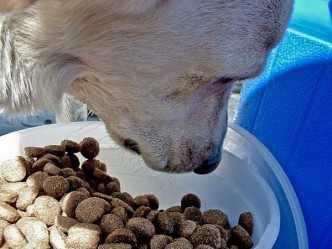Seven Reasons Why That Premium Pet Food
May Not Be Worth Your Money

You’re a smart discerning dog owner who knows the value and importance of buying a top quality pet food for your dog.
Perhaps you went to your local pet shop and picked out a a bag of food labeled natural/organic, grain-free, etc.
You didn’t skimp on quality, and this bag of food isn’t cheap!
But is it worth your money?
“Your good intentions are there, but here’s 7 reasons why it may not be worth your money to buy “premium” quality commercial dog food.”
1. It Lacks Freshness (aka Gu Qi Food Power)
Although commercial dog food (dry or canned) is preserved for a longer shelf life, after shipping and storage it may sit in a veterinarian’s office for months.
Depending upon storage temperature, humidity and the manufacturing date, food will gradually degrade over time.
The high degree of processing that the ingredients are subjected to change many of the molecules to an inert state, and Traditional Oriental Medicine (TOM, also called Traditional Chinese Medicine) considers the food without Qi, or “dead food,” “lacking in Spirit.” Instead of providing Qi to the body, the food “drains Qi” from the body because it takes more energy to digest, absorb, and assimilate the processed ingredients.
Fresh cooked and raw vegetables are essential to the process of healing, preventing cancer, and decreasing inflammation in the body, for both dogs and people (and all animals, really).
2. It Lacks Diversity

“Kibble again? Aww.” 🙁
Would you consider eating the same health bar three times a day, every day, all year round for years, if it promised to keep you healthy?
Probably not, right? Especially because it’s not “natural.” It does not even make sense.
So how can feeding dogs the same food daily for months and years be justified? Your body and your environmental conditions change all the time, and thus, your nutritional needs will change as well.
You simply can’t get all of your nutritional needs met through a diet that never changes. The same is true for your dog.
3. It’s Not Specifically Tailored For YOUR Dog
Food as medicine is at the heart of Traditional Oriental Medicine.
Each individual dog has specific needs that only a home-prepared/intentional diet can address. This is especially important for dogs that are experiencing a serious health crisis. Using principles of diet/nutritional therapy, you can modify your pet’s diet to fit your dog’s constitution and current symptoms (disharmonies).
The TOM approach recommends we eat what is appropriate for the season, climate, and our geographical location (latitude and altitude) by rotating proteins, starches, and vegetables. Additionally, an individual’s life style, exercise and constitution (i.e. age, sex, past medical history, current symptomology and physical health or deficiencies, and energetics) need to be evaluated in order to make appropriate food choices that bring the individual’s energy and health back into balance.
4. It Lacks Quality
Even “good” brands like Wellness suffer from pet food recalls from time to time. That’s just the nature of producing pet food on a mass scale.
Quality is important because it contributes to the essence of food’s “Gu Qi.”
If the most expensive dry dog food on the market costs $60 a bag, and feeds a 75-lb. Labrador Retriever for one month, or $2 per day, wouldn’t you question the quality of the ingredients? Let’s consider the production costs that each bag of food needs to cover:
- Ingredients
- Profits
- Distributor costs
- Packaging
- Shipping
- Advertising/marketing
With all of these production costs going into one bag of food, it’s not uncommon for ingredient costs to be sourced for around 25% of the total costs (which, in this particular example, breaks down to about 50 cents per day). 50 cents!
As a point of reference, ground hamburger suitable for human consumption goes for $4/lb. What do you suppose the per pound price is for the meat/protein included in each bag of “premium” commercial pet food?
Commercial pet food companies are uncomfortable with the mention of testing their food for pesticide, herbicide, antibiotic, toxic metal, dioxin, or PCB presence, and it’s little wonder why.
5. It Doesn’t Strengthen the Relationship Between You and Your Dog
Humans and dogs have evolved living together eating similar foods for over 10,000 years. The act of sharing food strengthens the dog-human bond. Dogs have been eating human “table scraps” for thousands of years.
Wolves domesticated themselves in response to humans providing them a new ecological niche, that is, ‘permanent’ human settlements with the opportunities of feeding on garbage, which probably contained discarded cooked and raw meat scraps.
With the advent of fire and cooking, humans were able to make their food more bioavailable and nutritious. Wolf-dogs were now able to utilize the nutrients from discarded food scraps, mostly tubers (starches) and cereals. In the 1700’s when only the aristocracy and the rich could afford to keep and breed dogs for hunting and pleasure, dog owners shared their human food.
6. It Isn’t Purposeful
The Art and Spirit of Cooking developed in Asia over thousands of years, and is closely associated with Nature’s laws.
Food can be categorized by taste, color, texture, smell, and health benefits. Using this information can help create delicious food that is healthy and functional. The Japanese term Wa Shoku describes food preparation that is not only balanced nutritionally, but contains aesthetic harmony.
7. It Lacks Love and Respect

When you look at a bag or can of dog food most people do not take into consideration from where the ingredients originated, the animals that suffered in the process, and the people working low level jobs under harsh conditions in the pet food industry, at slaughter houses and rendering plants.
Where is the Love?
There is a Buddhist saying: “Bless the food and bless the people who contributed in growing and making it.”
What Can You Do? Make Your Own Food!
Would you like to learn how to make food for your dog that meets these criteria and more? In my cookbook Fresh Food and Ancient Wisdom I show you how to create easy, simple, healthful meals that are tailored for the needs of your dog.
Making home prepared food for your dog doesn’t have to take a lot of time or money (and you can even learn how to prepare meals that you can eat too …with some additional seasoning, of course)!
